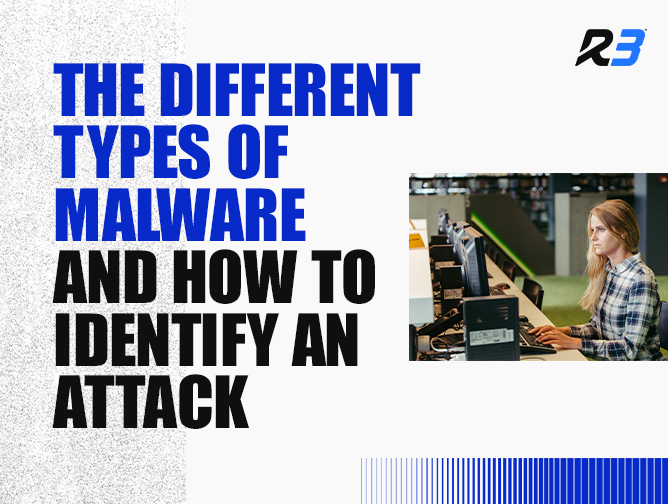Malware, or malicious software, is an ever-evolving threat to cybersecurity, with various types designed to exploit, damage, or disable computers and networks. Understanding the nuances between different forms of malware is critical for IT professionals tasked with safeguarding digital assets. This blog post delves into the core types of malware, their distinctive characteristics, and effective strategies for prevention and remediation. We will also cover the differences between viruses, worms, Trojan viruses, spyware, adware, and ransomware.

Download 6 Common Cyber Attacks & How to Prevent them
Check out our free eBook on 6 Common Cyber Attacks and How to Prevent them.
Malware 101
What is malware?
Malware is a type of software that is designed to harm computer systems, steal data, or perform other malicious activities. Malware can be distributed through email attachments, software downloads, infected websites, and other means.
How is malware typically distributed?
Malware can be distributed in a variety of ways, including email attachments, software downloads, infected websites, and social engineering tactics. Social engineering involves tricking users into downloading and installing malware by posing as a legitimate software or service.
How to identify a malware attack?
Malware can be identified through various means, such as suspicious network activity, slow system performance, unusual pop-ups or error messages, and changes in browser settings. Additionally, antivirus software can help identify and remove malware from a system.
The potential risks and consequences of being infected by Malware
- Frequent system crashes and slow performance.
- Unexpected behavior from software or files appearing without user’s knowledge
- Loss of critical data
- Downtime and operational disruption
- Financial repercussions from ransom payments
- Monitoring user activities
- Collecting keystrokes, logins, and financial information
- Malware can significantly slow down computers
- Adware specifically can disrupt user experience with intrusive ads
- Compromised privacy through unwarranted data collection
- Identity theft
- Financial fraud
- Leaks of confidential information
Best practices for avoiding getting infected with malware
To avoid malware, it is essential to keep software and operating systems up to date with the latest security patches and updates. It is also important to avoid downloading software from untrusted sources and to use antivirus software to protect against known threats. This post covers five elements of a multi-layered Defense in Depth strategy.
- Avoid opening attachments or clicking on links from unknown sources. Here are some reasons to use an MSP for email security and management. And you can view our email security specific services here.
- Regularly back up your data to recover from potential losses.
- Avoid using unauthorized software or media.
- Ensure all anti-malware tools are regularly updated.
- Keep all systems and software updated with the latest security patches (not just your anti-malware tools).
- Limit user privileges to install or run unknown executables. Be cautious with all permissions granted to your applications and services.
- Implement strong network security protocols, segmentation, rigorous access controls and application whitelisting.
- Conduct regular vulnerability assessments and penetration testing.
- Educate users on the dangers of unsolicited email attachments and social engineering tactics.
- Train employees on ransomware tactics and safe computing practices.
- Segment networks and have multiple levels of security to limit the spread of infections.
- Install ad-blocking tools and privacy-enhancing browser extensions.
- Only download software from reputable sources.
- Regularly update your operating system and applications to close security gaps.
Useful tools for preventing Malware
- Advanced heuristic analysis tools to detect virus signatures.
- Bootable antivirus tools for cleaning infected systems that won’t start normally.
- Secure email gateways
- Application control systems
- Antivirus software with real-time scanning and adware detection
- Patch management systems
- Network monitoring solutions
- Endpoint protection suites
- Email filtering software
- Intrusion detection systems (IDS)
- Backup solutions (e.g., cloud and local backups)
- Anti-ransomware tools (e.g., Bitdefender Anti-Ransomware)
- Sandboxing software to run applications safely
- Antispyware programs (e.g., Malwarebytes, Spybot)
- Firewall solutions (hardware and software-based)
- Encrypted communication tools (e.g., VPNs)
- Adblockers (e.g., AdBlock, uBlock Origin)
- Privacy browsers (e.g., Brave)
Types of malware
There are several types of malware, each with its own unique characteristics and potential for damage. Below are brief definitions of each type of malware.
Virus
Viruses are malware that attach themselves to executable files or boot records to spread and carry out harmful actions. A virus is a type of malware that spreads by infecting other files or software on a system. Once a virus infects a system, it can replicate and spread to other systems.
A virus is often distributed in a few primary ways; file sharing, infected removable drives, and phishing campaigns.
If you’re infected with a virus there a few things you need to do but to start you should disconnect the device from all networks, run a comprehensive scan, and consult with an IT professional. Otherwise, consider reverting to a system restore point prior to the infection to roll back changes and inform relevant authorities if sensitive data is compromised. Please note that depending on the progression of malware threats and the emergence of new types, additional measures may be advised, and the above best practices should be updated accordingly.
Worms
A worm is a type of malware that spreads through networks and can replicate itself without user interaction. Worms can cause significant damage to computer systems by consuming resources and slowing down network traffic. Worms are standalone malware programs that replicate themselves to spread to other computers, often exploiting network vulnerabilities. Unlike viruses, they do not require a host file or program to spread and can autonomously infect other systems on a network. Some of the most notorious worms include SQL Slammer, which remarkably slowed down global internet traffic in 2003, and Conficker, known for infecting millions of computers worldwide.
A worm will typically be distributed through unpatched software vulnerabilities, network shares, and email attachments.
If you’re infected with a worm you should start by quarantining the infected devices to prevent further spread. Then you should identify and patch exploited vulnerabilities and clean affected systems using a virus removal tool.
Trojan virus
A Trojan virus is a type of malware that disguises itself as legitimate software but has malicious intent. Trojan viruses can be used to steal sensitive information, create backdoors for remote access, or install other types of malware on a system.
A trojan virus is typically distributed through phishing emails, which trick users into downloading what appears to be trusted attachments. Fake software updates that prompt users to install malevolent versions of legitimate updates is another method of transmission. And one other common method is through compromised websites, often those that have been hacked or injected with malicious code, serving as a platform to distribute Trojans.
If you’re infected with a trojan virus you should; isolate the infected system, use a malware removal tool for trojans, and finally you should review and strengthen network access points.
Ransomware
Ransomware is a type of malware that encrypts files on a computer system and demands payment in exchange for the decryption key. Ransomware can cause significant damage to businesses and individuals by preventing access to critical data. Ransomware is an extortion-based malware that encrypts the victim’s data, demanding payment for the decryption key.
If you’re infected with ransomware you should; refrain from paying the ransom, restore systems from your backups, and work with a cybersecurity expert to assess the scope of the attack.
Spyware
Spyware is a type of malware that is designed to collect sensitive information from a computer system, such as login credentials, browsing history, and keystrokes. Spyware can be used for various purposes, including identity theft and corporate espionage.
If you’re infected with spyware you should disconnect from the internet, remove suspicious applications, and change passwords for all sensitive accounts.
Adware
Adware is a type of malware that displays unwanted advertisements on a computer system. Adware can slow down system performance and interfere with user productivity.
Adware is typically delivered through deceptive links or websites, email attachments, or it can be bundled with free software downloads.
If you’ve been infected with Adware be sure to use a credible adware removal tool, clear browser caches and cookies and conduct a full system antivirus scan.
Summing it all up
While all types of malware can cause significant damage to computer systems, there are some key differences between them. Viruses and worms both replicate themselves, but viruses require an infected file or software to spread, while worms can spread without user interaction. Trojan viruses are disguised as legitimate software, while spyware is designed to collect sensitive information. Adware displays unwanted advertisements, while ransomware encrypts files and demands payment for decryption.
Malware is a significant threat to computer systems and can cause significant damage to individuals and businesses. Understanding the different types of malware and how to identify and avoid them is essential for maintaining the security of computer systems. By following best practices and staying vigilant, users can protect themselves from the harmful effects of malware. If you suspect that your organization is vulnerable to an attack or if you have been compromised, contact the cybersecurity team at R3 for assistance.






